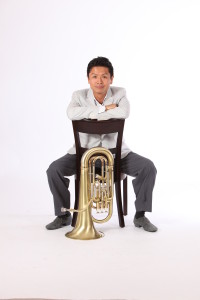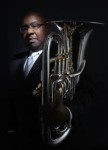If you are holding a euphonium and a woman grabs you in a passionate embrace, it just might be the tango. If your name is Koichiro Suzuzki, then it most definitely is! Nurtured by the River City Brass Band, Suzuki has created a niche for euphonium that bears repeating. The “Fourth Valve” tm is delighted to host euphonium tango master Suzuki, & we bet we know what you young euphonium players will be doing this summer!

 1. When did you fall in love with the Tango?
1. When did you fall in love with the Tango?
I’ve been in love with Argentine tango since 2004. The first time I experienced tango was in a class provided by the University of Wisconsin-Milwaukee-(where I went for my underÂgradÂuÂate study in music). From that day, I knew that it was something I’d love to do for the rest of my life.
2. How does playing tangos inform your dancing, and how does dancing tangos inform your playing?
Dancing tango is improvisational so it helps me to understand more about music structures and rhythm.
Some tango songs are not for dancing, and it helps to know which songs are better for dancing.
3. What is special and unique about Buenos Aires?
Tango! (Of course….). But Buenos Aires is like Paris in South America. It has a European style of architecture and an extremely rich cultural life.
Cuidado Thrills on Libertango
.
4. How does the euphonium fit in with the tango, and who does the arrangements for your group Cuidado?
It is always challenging but a Euphonium’s mellow and smooth sound fits well in Tango. Here the euphonium can be used as a melodic instrument as well as the rhythmic bass line.
Because of the unique orchestration, our band does all of the arrangements.
 > 5. How did Cuidado come about?
> 5. How did Cuidado come about?
When I was in graduate school, I wanted to create something different as an ensemble. I wanted to combine both of my passions into one idea.
6. How would you contrast the differences in your approach to commercial music as opposed to classical. Any different concepts, techniques or equipment?
I usually exaggerate accents and staccato when I play tango songs, but other than than that, I play same instrument and mouthpiece when I play with band.
7. What are your musical inspirations?
Astor Piazzolla
Osvaldo Pugliese
Gustav Mahler
Beethoven
Alan Bear
Non-musical?
Akira Kurosawa
Eternal Tango, by Cuidado
8. Could you discuss the rhythmic and style aspects of the Tango?
Traditionally, Tango songs have accents on beats one and four. Rhythmic changes to two syncopating accented dotted quarter notes followed by a quarter note is popular as well.
9. What advice would you give to young euphonium players?
Practice hard and have fun playing euphonium!
c. 2015 David William Brubeck All Rights Reserved. davidbrubeck.com
Images courtesy of the Koichiro Suzuki and The Pittsburgh Post Gazette
Interested in more “The Fourth Valve” tm Interviews?
 Don Harry
Don Harry
John Stevens
Jim Self
John Van Houten
Demondrae Thurman
Deanna Swoboda
R. Winston Morris
 Beth Wiese
Beth Wiese
Aaron Tindall
Marty Erickson
Beth Mitchell
Chitate Kagawa
Aaron McCalla


